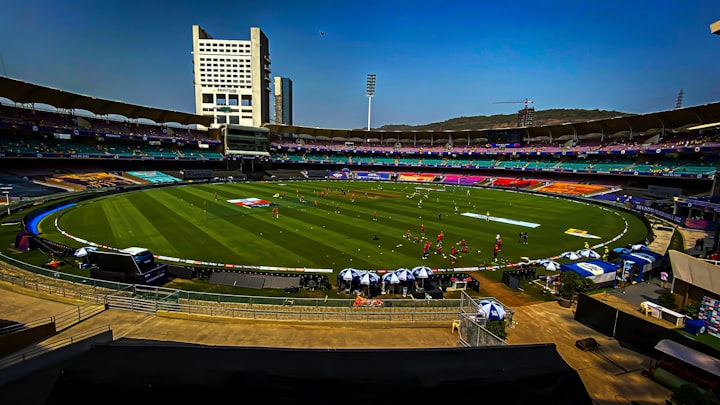
Cricket was introduced to the Indian subcontinent by British sailors in the 18th century, and the first cricket club was established in 1792. India's men's national cricket team played its first international match on 25 June 1932 in a Lord's Test against England becoming the sixth team to be granted Test cricket status. India had to wait until 1952, almost twenty years, for its first Test victory. In its first fifty years of international cricket, success was limited, with only 35 wins in 196 Tests.[12] The team, however, gained strength in the 1970s with the emergence of players like Sunil Gavaskar, Gundappa Viswanath, Kapil Dev, and the Indian spin quartet.
In men's limited-overs cricket, India made its ODI and T20I debuts in 1974 and 2006, respectively. The team has won five major ICC tournaments, winning the Cricket World Cup twice (1983 and 2011), the ICC T20 World Cup once (2007) and the ICC Champions Trophy twice (2002 and 2013) and have also finished as runners-up in the World Cup once (2003), the T20 World Cup once (2014), and the Champions Trophy twice (2000 and 2017). The team were also runners-up in the inaugural 2019–2021 ICC World Test Championship. It was the second team after the West Indies to win the World Cup and the first team to win the World Cup on home soil after winning the 2011 Cricket World Cup.
They have also won the Asia Cup seven times, in 1984, 1988, 1990–91, 1995, 2010, 2016 and 2018, whilst finishing runners-up thrice (1997, 2004, 2008). The team also won the 1985 World Championship of Cricket, defeating Pakistan in the final. Other achievements include winning the ICC Test Championship Mace five times and the ICC Men's ODI Team Rankings Shield once.
As of May 2023, the team is ranked first in Tests, third in ODIs and first in T20Is by the ICC.[13]
History
Edit
See also: Cricket in India § History
Early history (1700s–1918)
Edit
See also: History of cricket in India to 1918
The British brought cricket to India in the early 1700s, with the first cricket match played in 1721.[14] In 1848, the Parsi community in Mumbai formed the Oriental Cricket Club, the first cricket club to be established by Indians. After slow beginnings, the Europeans eventually invited the Parsis to play a match in 1877.[15] By 1912, the Parsis, Hindus, Sikhs and Muslims of Bombay played a quadrangular tournament with the Europeans every year.[15] In the early 1900s, some Indians went on to play for the England cricket team. Some of these, such as Ranjitsinhji and Duleepsinhji were greatly appreciated by the British and their names went on to be used for the Ranji Trophy and Duleep Trophy – two major first-class tournaments in India. In 1911, an Indian men's cricket team, captained by Bhupinder Singh of Patiala, went on their first official tour of the British Isles, but only played English county teams and not the England cricket team.[16][17]
Test match status (1918–1970)
Edit
See also: History of cricket in India from 1918–19 to 1945, History of cricket in India from 1945–46 to 1960, and History of cricket in India from 1960–61 to 1970
Lala Amarnath batting during a match against Middlesex at Lord's, c. 1936[18]
C. K. Nayudu, India's first captain in Test cricket
India was invited to the International Cricket Council in 1926, and made their debut as a Test playing nation in England in 1932, led by CK Nayudu, who was considered the best Indian batsman at the time.[19] The one-off Test match between the two sides was played at Lord's in London. The team was not strong in their batting[20] at this point and went on to lose by 158 runs.[21] India hosted its first men's Test series in the year 1933. England was the visiting team that played two Tests in Bombay (now Mumbai) and Calcutta (now Kolkata). The visitors won the series 2–0. The Indian team continued to improve throughout the 1930s and '40s but did not achieve an international victory during this period. In the early 1940s, India didn't play any men's Test cricket due to the World War II. The team's first series as an independent country was in late 1947 against Don Bradman's Australian cricket team in England in 1948 (a name given to the Australia national cricket team of that time). It was also the first Test series India played which was not against England. Australia men's cricket team won the five-match series 4–0, with Bradman tormenting the Indian bowling in his final Australian summer.[22] India subsequently played their first Test series at home not against England, but against the West Indies in 1948. West Indies won the five Test series 1–0.[23]
Elizabeth II with members of the Indian team during the Indian tour of England in 1952
India recorded their first Test victory, in their 24th match, against England at Madras in 1952.[24] Later in the same year, they won their first Test series, which was against Pakistan.[25] They continued their improvement throughout the early 1950s with a series win against New Zealand in 1956. However, they did not win again in the remainder of the decade and lost badly to strong Australian and English sides. On 24 August 1959, India lost by an innings in the Test to complete the only 5–0 whitewash ever inflicted by England.[26] The next decade saw India's reputation develop as a team with a strong record at home. They won their first Test series against England at home in 1961–62 and also won a home series against New Zealand. They managed to draw home series against Pakistan and Australia and another series against England. In this same period, India also won its first series outside the subcontinent, against New Zealand in 1967–68.[27]
The key to India's bowling in the 1970s were the Indian spin quartet – Bishan Singh Bedi, E. A. S. Prasanna, B. S. Chandrasekhar and Srinivasaraghavan Venkataraghavan. This period also saw the emergence of two of India's best ever batsmen, Sunil Gavaskar and Gundappa Viswanath. Indian pitches have had the tendency to support spin and the spin quartet exploited this to create collapses in opposing batting line-ups.[28][29] These players were responsible for the back-to-back series wins in 1971 in the West Indies and in England, under the captaincy of Ajit Wadekar. Gavaskar scored 774 runs in the West Indian series while Dilip Sardesai's 112 played a big part in their one Test win.[30][31][32]





Comments (1)
Super